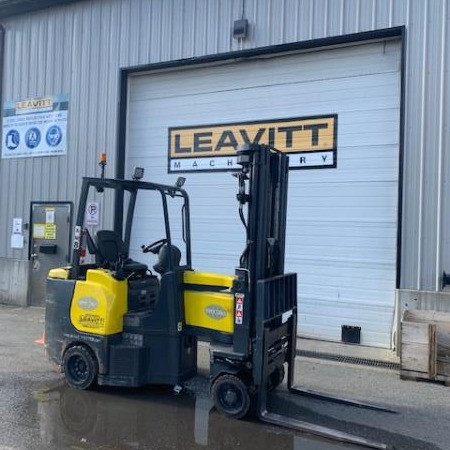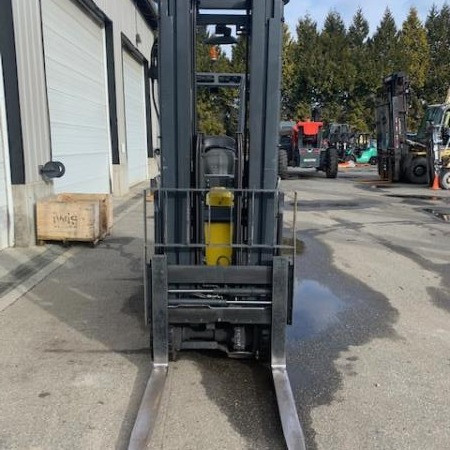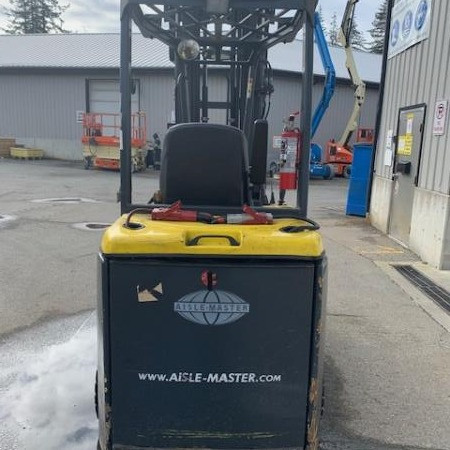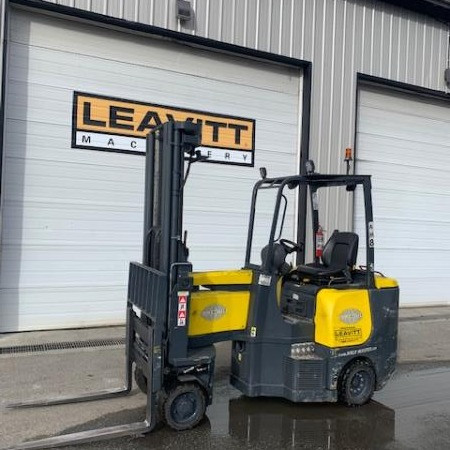Very Narrow Aisle Forklift Louisiana
Used Very Narrow Aisle Forklift Louisiana - Warehousing needs greatly focus on space-saving techniques and layout to maximize expensive square footage and decrease travel time needed to get goods from the loading docks and from point A to point B. Extremely narrow aisles offer more storage space since there is less space needed for aisle access. Configuring the warehouse is known as warehouse optimization.
Warehouse Optimization
Several benefits can be enjoyed for adding very narrow aisle warehouse optimization such as more storage space for the facility.
Using narrow forklift trucks instead of traditional forklifts can enable the warehouse width of the aisles can be lessened to half. Many very narrow aisle forklifts offer greater stack height capability which further increases the storage capacity per square foot. This means that costs are decreased because less warehouse space is necessary for the same amount of stock than if a standard aisle configuration were used. Square footage is costly in urban areas and any way to reduce warehousing costs can save a company money. Warehouse storage can be increased up to eighty percent with careful planning when a narrow aisle width configuration is utilized. In addition, a very narrow aisle layout allows for more rack faces as well as better access to products. This usually equates to less travel time gathering and storing product as more product is located within a smaller, more accessible area.
It is common for warehouses to use a very narrow or narrow aisle layout. Narrow aisles are measured as those that use fewer than eleven feet of aisle width. Very narrow aisles reduce the aisle width further to around six-and-a-half feet. Storage options are greatly increased with these aisle width options. Standard forklifts can have issues with turning in these aisle widths. A variety of very narrow forklifts have been designed to easily maneuver in narrow aisles.
When selecting a forklift for a job application, it is essential to know the aisle dimensions. It is important to have the correct aisle dimensions before forklift shopping to avoid securing a machine that won’t fit its’ intended location. It is essential to take any columns, posts or utilities into account before deciding a type of narrow aisle forklift design as these can block access.
Very Narrow Aisle Forklift Trucks
As these units are mostly powered by electricity, rechargeable batteries are popular for very narrow aisle forklifts. Very narrow aisle forklift trucks are popular as stand-up riders to help increase operator comfort and productivity. The most commonly used types of very narrow aisle forklift trucks are:
1. Reach trucks
2. Order pickers;
3. End-control riders; and
4. Turret or swing-mast.
Reach Forklift Trucks
The reach trucks were created as a type of rider stacker forklift but can be modified specifically for narrow aisle usage. It got its name by its function of reaching its forks forward to get to a load. The two kinds of reach trucks the moving carriage and the moving mast. The moving carriage works by raising and lowering the carriage, along with the operator. While the operator stays at ground level, the moving mast is responsible for raising and lowering the forks. The moving reach truck is typically considered the safest out of the two kinds of reach trucks. These machines rely on a kind of jointed framework known as a pantograph system that enables the operator to place a load or reach the load without moving the machine.
Order Pickers
Order pickers were created to specifically pick orders from difficult-to-access racks. Order pickers are specific for lighter stock items that can be lifted by hand. They lift the operator up to reach the goods by identifying and choosing certain items to create an order.
End-Control Riders
End-control riders can pick up loads along the floor level and transport goods horizontally instead of transporting items over heights.
Turret or Swing-Mast Forklift
Swing-mast or turret very narrow aisle forklifts feature an articulating swivel mast that pivots. The mast swivels to enable pallets to be positioned on the right or left side of the forklift.
Guided Very Narrow Aisle Trucks
Many very narrow aisle forklift trucks are able to be guided down aisles by wire or rail.
Since the forklift truck is guided, the chance of colliding with racks while traversing down the aisles is very low. In rail-guided models, sets of rails are placed into the floor on each side of the aisle. They run the length of the aisle and also curve around the aisles’ edge. The forklift is fitted with special wheel guides that slide into the rails, preventing the forklift from moving outside the rail guards.
Wire-guidance forklift systems install wires on the floor instead of rails and the wires run down the middle of the aisle. Narrow aisle forklifts rely on a wire-guide system to help it communicate with the floor wires. This allows the machine to be steered by the wires, stopping it from traveling outside of the specific location.
Work Site Considerations
There are a few critical considerations when implementing a very narrow aisle configuration. Because these very narrow aisle configurations include very tall racking systems, the condition of the floor and the construction of the racks must be done properly in order to avoid potentially disastrous outcomes. Four specific areas need to be perfectly prepared before a racking system can be implemented including a level floor, plumb racks, any floor cracks need to be repaired and the floor’s load capacity must be accurate. These locations need to be maintained and monitored continuously.
Level Floor
Because of the height of the racking systems, any slight slope of the floor is likely to negatively affect the plumbness of the racks, especially over time when loads are continuously placed and removed on the racks. A level floor is vital for the safety and integrity of the operator, employees, stock and the warehouse.
Crack Repair
When cracks in the floor are spotted, they should be assessed and, when necessary, repaired immediately. Cracks may affect the floor’s level and, when they are approximately 3/8 inches wide, will need to be properly filled with a material at least as hard as the surrounding floor.
Floor Load Capacity
The floor should meet certain minimum requirements before considering a narrow aisle configuration. At a minimum, the floor should consist of 3,000 psi concrete as well as contain evenly distributed rebar approximately 3 to 4 inches below the surface. Depending on the load requirements and configuration, additional reinforcements may be needed.
Plumb Racks
Of great importance is the proper installation of the racking system. There is a major chance of rack failure if improper installation occurs. All racks need to be plumb and this is one of the most vital aspects of correct installation. Rack shims can help the rack stay plumb to one inch at the height of thirty feet.
If the above measures are not taken or are improperly implemented, it is likely to cause a racking failure. Racking failure can kill or injure employees, damage equipment and result in horrible damage. Due to these potential problems, the most significant part of creating a narrow aisle configuration for warehousing optimization is the initial measurements.
Very Narrow Aisle Forklift PDF
Stock Number: 208758 GL
Make: AISLEMASTER
Model: 44SE
Year: 2015
| Stock Number |
208758 GL |
| Make |
AISLEMASTER |
| Model |
44SE |
| Year |
2015 |
| Category |
Very Narrow Aisle Forklift |
Stock Number: 207213 GL
Make: AISLEMASTER
Model: 44E
Year: 2013
| Stock Number |
207213 GL |
| Make |
AISLEMASTER |
| Model |
44E |
| Year |
2013 |
| Category |
Very Narrow Aisle Forklift |
Stock Number: 209213 GL
Make: AISLEMASTER
Model: 44SE
Year: 2015
| Stock Number |
209213 GL |
| Make |
AISLEMASTER |
| Model |
44SE |
| Year |
2015 |
| Category |
Very Narrow Aisle Forklift |













